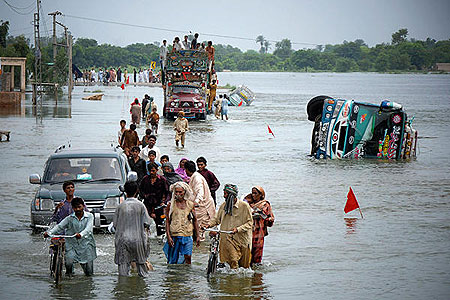In order to avoid substandard handling of disasters, with repercussions of preventable disaster effects spilling over to neighbouring areas or countries in the region and beyond, standardised methods should be used but essentially with climate change considerations.


In order to avoid substandard handling of disasters, with repercussions of preventable disaster effects spilling over to neighbouring areas or countries in the region and beyond, standardised methods should be used but essentially with climate change considerations.
Such methods should include those promoted by the International Strategy for Disaster Reduction (ISDR), currently contained in the Hyogo Framework for Action (HFA) 2005 – 2015 under the theme "Rebuilding the Resilience of Nations and Communities to Disasters”.
This is because no country can succeed limiting natural disasters to its borders. For instance, it is not possible for any country to limit storms, floods, landslides, earthquakes and volcanoes to its borders, not to spread to neighbouring countries or other countries.
Likewise, no country is capable of limiting health related disasters, such as epidemics, to its borders. It is for this reason that policies, programmes, projects and activities concerning disasters should be based on standardised methods of disaster prevention and management such as those cited above of the Hyogo Framework for Action.
Given that these methods are well researched and carefully thought over, aiming at substantially reducing disaster losses in lives, in the social, economic and environmental assets of communities and countries, they should be used as international standard. The methods also aim at enhancing the Hyogo Framework’s Strategic Goals, which are:
(i) The integration of disaster risk reduction into sustainable development policies and planning
(ii) The development and strengthening of institutions, mechanisms and capacities to build resilience to hazards
(iii) The systematic incorporation of risk reduction approaches into the implementation of emergency preparedness, response and recovery programmes.
Using parochially or individually recognised methods only serves to cause havoc and confusion in the modern world of standardisation and acting together.
In a bid to come up with better methods, all countries should use their respective National Bureaus of Standards, to come up with new methods and communicate them to their regional economical blocs like the East African Community and the International Standards Organisation (ISO) respectively for testing and adopting them for use in the region or globally.
Copenhagen Science Conference Recommendations
According to Dr Balgis Osman-Elasha of Higher Council for Environment and Natural Resources, Sudan,
during the Copenhagen Science Conference in March 2009, climate change fans and or orchestrates the threat of disaster risks. He described it as one of the greatest threats to development such that 53 per cent of disasters in Africa are climate-related and one-third of the African people live in drought-prone areas.
He also expressed his fear that by 2020 yields from water-fed agriculture in Africa will be down by 50 per cent. What a risk!
In response to his observations and those of other experts, the Conference made a global Call for a FAIR and SAFE deal. Fair in the sense that rich countries take responsibility for the crisis they have caused the world including poorer countries and let them develop in a carbon-constrained world.
It should be noted here that the caused carbon emissions in the atmosphere have interrupted and continue to interrupt with weather patterns and it is developing countries, Rwanda and the whole of Africa inclusive that are most hampered to develop.
The developed countries have by so doing put hurdles and or stumbling blocks in the way or path of developing countries to develop.
The discourse on fairness also required developed countries which have caused this calamity to appreciate that developing countries need $150bn a year to cope with the effects of climate change (adaptation) and pursue their own low carbon futures (mitigation).
Interestingly, however, the ‘timely’ Conference did not go further to recommend an ideal Implementation Plan or Timetable, including ways of enforcing the same. It is my hope that the various Climate Change Concern Conferences that have taken place in different parts of the world after the Copenhagen Conference have addressed this.
If they have, little is known by the public in the developing countries to us to cause us analyse and constructively respond to the performance. Information on the same should be published from time to time by UNDP, the World Bank or other UN agency on the issue, including names of rich countries that have so far made their money contributions or pledged to do so and when.
Information is also needed as and when the particular UN agency disburses this money to countries, including the amounts.
Another fairness requirement is that every country in the world, rich or poor, should have an effective policy and practice at national level for ensuring that developing funds reach the poorest.
As regards safety, the Conference recommended that there should be a global reduction of emissions by at least 80% (on 1990 levels) by 2050 and that carbon emissions peak and decline by 2015. It was also recommended that rich countries cut emissions by 40% (from 1990 levels) by 2020.
Similar to what is cited earlier, there is a need for a Timetable as to how each country will proportionally and gradually cut global emissions from year to year, to achieve 80% by 2050. Likewise, the Conference did not press for the need for a known or published Timetable on how the carbon emissions will peak and decline by 2015.
While the move was indeed a step in the right direction, it may remain sheer rhetoric when there is no corresponding Implementation Table and no clearly seen enforcement measures.


